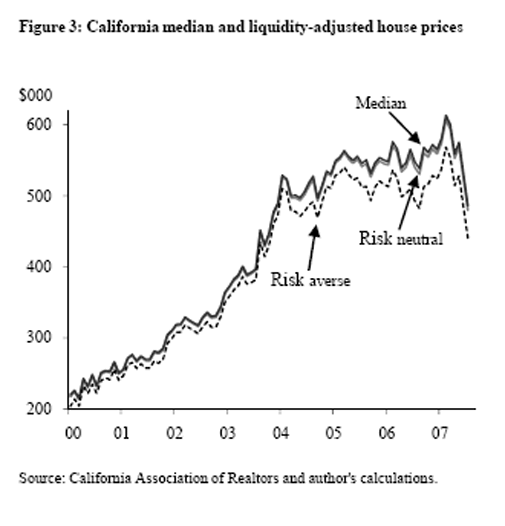Ok, so it was a messy weekend of NCAA March Madness hoops but I am in 7th place, beating out my 9 year old (yes!) but losing to my 14 year old (rats).

In this paper Falling House Prices and Rising Time on the Market by an economist at the San Francisco Fed. Author John Krainer comments it is fascinating how most people find falling housing prices so interesting yet stocks rise and fall every day.
The paper discusses to types of house prices:
Observable value: the price the property sold for that was recorded in public record or some data collection agency.
Liquidity adjusted value: the price a seller would be willing to take for the house immediately without waiting for an ultimate buyer to pay list price.
He is essentially using days on market to measure to measure liquidity. In a tight real estate market, the spread between the actual market value and the liquidity price is minimal because properties tend to sell very quickly.
I sort of have an issue with his logic because the observable price reflected in public record transactions includes sales where the seller was not willing to wait for the length of a typical days on market period.
Nevertheless, in a market with expanding inventory and therefore longer marketing times, the spread between the actual market price and the liquidity price will expand. In an extreme case, such as a foreclosure auction sale, the discount achieved in the auction reflects the declining market conditions over a particular holding period.
In a market that is dropping 10% per year, a 20% discount at auction today would be the equivalent of waiting for a year to sell the property as the market drops. The decline is compressed into a one day auction rather than 12 months of exposure. The auction discount should be higher than the market decline because there is reduced holding costs and risk in selling quickly if the seller is certain the market is continuing to erode. However getting rid of the seller’s sense of denial of a decline in weak housing market may be impossible to overcome.
The author suggests:
>Taking into account the slowing sales volumes and rising time on the market might well imply even lower house values than suggested by the recent transaction price data.
The same thing occurred in price increases of 2004-2005. The number of sales dropped sharply and marketing times began to expand, yet housing prices continue to rise. These three indicators need to be considered in unison.
This weekend, I was quoted in the New York Times article that reflects that change in mindset of the market.
>Jonathan Miller, the president and chief executive of Miller Samuel, a Manhattan real estate appraisal company, remembers appraising a studio co-op apartment in the now-exclusive Tudor City for $11,000 in 1990.
>Even though he could afford to charge the studio on his Visa, he decided that it wasn’t worth the risk. “There was great concern whether many of these co-ops would remain solvent,” he said.
I remember thinking, what a deal! But then quickly changed my thinking, saying, no way! Too much risk. In hindsight, that decision in 1990 seems so clear. That’s a challenge appraisers face when valuing property at a previous point in time, usually in litigation matters, to understand the mindset of the market at that point in time.
It ain’t just price.

